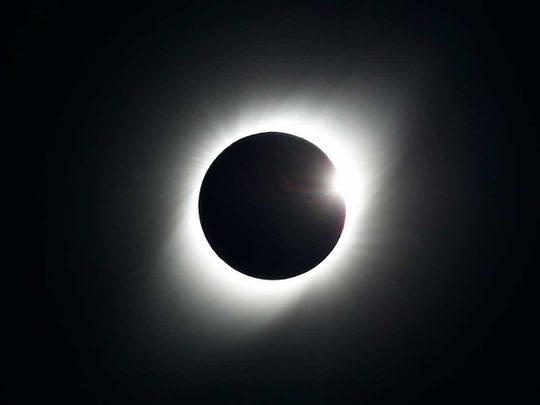
Highlights
- The eclipse will start at 9:36 p.m. Eastern time.
- It will first be visible in the Indian Ocean and then move across to the Pacific Ocean, providing the best views for those in Western Australia, East Timor and eastern Indonesian islands.
- The moon will completely cover the sun for over one minute in Timor at 12:16 a.m. Eastern time.
- The hybrid eclipse will end at 2:59 a.m. Eastern time on April 20.
A rare solar eclipse will cross over remote parts of Australia, Indonesia and East Timor on Thursday.
The lucky few in the path of the hybrid solar eclipse will either get plunged into the darkness of a total eclipse or they'll see a “ring of fire” as the sun peeks out from behind the moon.
Hybrid eclipses are rare among eclipses and occur only a few times a century, according to EarthSky. Out of 224 solar eclipses in the 21st century, seven will be hybrid. After today's eclipse, the next hybrid eclipse will be in 2031.
Watch: Solar eclipse live stream
The eclipse path will swoop from the Indian Ocean to the Pacific Ocean, mostly over water. For those viewing the total eclipse, it will last a little over a minute.
Such celestial events happen about once every decade: The last one was in 2013 and the next one isn’t until 2031. They occur when Earth is in the “sweet spot” so the moon and the sun are almost the exact same size in the sky, said NASA solar expert Michael Kirk.
At some points, the moon is a little closer and blocks out the sun in a total eclipse. But when the moon is a little farther away, it lets some of the sun’s light peek out in an annular eclipse.
Those outside the eclipse path can still watch from a distance: Some sites in Australia will stream the event online, including the Perth Observatory and the Gravity Discovery Centre and Observatory.
Several other upcoming solar eclipses will be easier to catch. An annular eclipse in mid-October and a total eclipse next April will both cross over millions of people in the Americas.
What is a hybrid eclipse?
Hybrid eclipses are a combination of a total and annular eclipse.
A total solar eclipse occurs when the moon passes between our planet and the sun, and the moon fully obscures the sun. An annular solar eclipse occurs when the moon passes between our planet and the sun, but the moon is at its furthest point from Earth. Because the moon is further away, it appears smaller than the sun and is unable to cover the star completely, leaving a ring of light from the sun.
During a hybrid eclipse, the Earth's curvature results in a different view across the globe, as the eclipse shifts between a total eclipse and an annular eclipse, according to NASA.
How it is different from a total eclipse?
A total eclipse occurs when the moon completely obscures the sun, whereas an annular eclipse occurs when the moon obscures the sun but appears smaller, leaving the outline of a solar ring and the rare hybrid eclipse takes place when both occur at the same time.
What time does it start?
In Western Australia the eclipse will be visible from 10:29 pm to 10:35 pm EDT on April 19 (2:29 to 2:35 GMT, April 20), in East Timor from 11:19 pm to 11:22 pm EDT on April 19 (3:19 to 3:22 GMT, April 20) and in Indonesia from 11:23 pm to 11:58 pm EDT on April 19 (3:23 to 3:58 GMT, April 20).
The eclipse will start from 9:36 p.m. Eastern time on April 19 and end at 2:59 a.m. Eastern time on April 20, according to In the Sky.
Location: When the eclipse is happening
The first location to see the partial eclipse begin: 1:34am UTC
The first location to see the full eclipse begin: 2:37am UTC
Maximum eclipse: 4:16am UTC
Last location to see the full eclipse end: 5:56am UTC
Last location to see the partial eclipse end: 6:59amUTC
Where can you view the eclipse?
The moon's shadow will move across Western Australia, East Timor and Indonesia, changing from a ring-shaped annular eclipse to a total eclipse and then back again. More countries will experience it as a partial eclipse with the moon obscuring just part of the sun, including Papua New Guinea, the French Southern Territories and the Marshall Islands, according to Space.com. The hybrid eclipse won't be visible in the UAE, but there are various free live streams online.
When is the next celestial event?
The next Eclipse (Partial) will be visible on August 2, 2027 and the next annular solar eclipse will occur in 2031. There are a total of seven hybrid solar eclipses in the 21st Century, with only four more after this year:
- April 8, 2005
- November 3, 2013
- April 20, 2023
- November 14, 2031
- November 25, 2049
- May 20, 2050
- December 6, 2067












